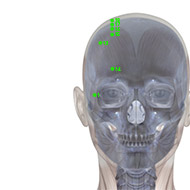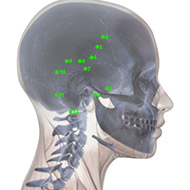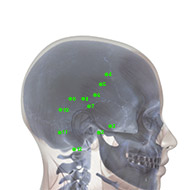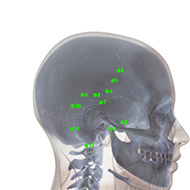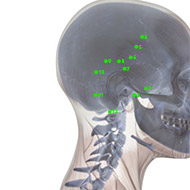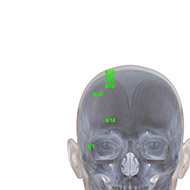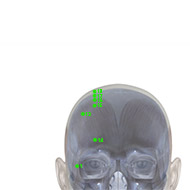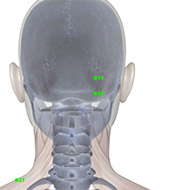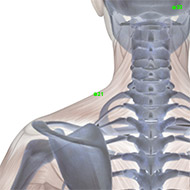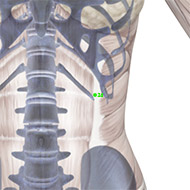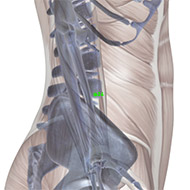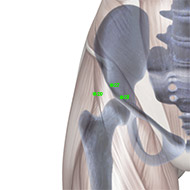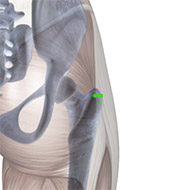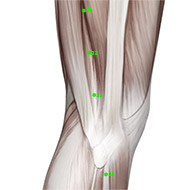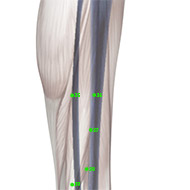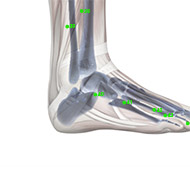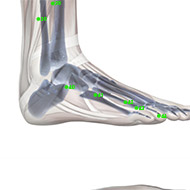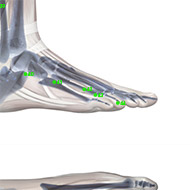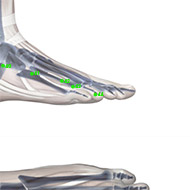Rated Acupoints
Gallbladder Meridian / Channel Acupuncture Points
Gallbladder Meridian / Channel Acupuncture Points.The meridian system (simplified Chinese: 经络; traditional Chinese: 經絡; pinyin: jīngluò, also called channel network) is a concept in Traditional Chinese medicine (TCM) about a path through which the life-energy known as “qi” flows.1 The twelve standard meridians, also called principal meridians, are divided into Yin and Yang groups. The Yin meridians of the arm are Lung, Heart, and Pericardium. The Yang meridians of the arm are Large Intestine, Small Intestine, and Triple Burner. The Yin Meridians of the leg are Spleen, Kidney, and Liver. The Yang meridians of the leg are Stomach, Bladder, and Gall Bladder.2 The Gallbladder Meridian or Gallbladder Channel is one of the 12 principal meridians in TCM. It corresponds with the Jueyin Liver Meridian of the Foot. The Flow Hours of this meridian are 11:00 AM – 1:00 PM.3
CONTENTS
ORGAN AND FUNCTION
ACUPOINTS
ORGAN AND FUNCTION
The Gall Bladder is responsible for absorbing excesses from the Liver. One of the functions of the Liver in Chinese medicine is to create smooth flow, specifically of Qi, Blood, digestion, and emotion. Gall Bladder dysfunction is characterized by Heat which is thought as arising from prolonged stagnation (inactivity), leading to resentment and festering anger. Further, an imbalance arising from vacuity of Gall Bladder function, is the pattern of Gall Bladder timidity. The Gall Bladder engenders the capacity for courage and bravery. Weakness in Gall Bladder function may manifest with a tendency towards fear and timidity. While the Liver is responsible for planning and organizing, the Gall Bladder is responsible for decisiveness and execution.4 The Gall Bladder also governs the right side of the body. This is simply due to its physical location alongside the Liver under the right ribcage, and therefore the preponderance of its energy on that side of the body. Using this metaphor, the Heart governs the left side of the body (there are other metaphors of left / right tropism in Chinese medicine, including Yang / Yin and Liver / Lung). Multiple symptoms occurring on the right side of the body often reflects a Gall Bladder dysfunction. Some of the most common of these include right-sided shoulder pain, hip pain, knee pain, and sciatica. These areas are traversed by the Gall Bladder channel.5
In addition, the Gall Bladder acts as a protector of the Heart. The Heart is protected by the Gall Bladder, and the Gall Bladder is protected by the appendix. They are affected by excess Heat and Dampness in ascending order of biological importance, with the Heart obviously appearing at the end as it is considered to be the ruler of the body.6
ACUPOINTS
This meridian contains 44 acupoints in one side, that is 88 acupoints in total.
GB-1
Location: 0.5 cun lateral to the outer canthus, in the depression on the lateral side of the orbit.
Indications: Headache, redness and pain of the eyes, failing of vision, lacrimation, deviation of the eye and mouth.
Acupuncture Method: Puncture subcutaneously 0.3-0.5 inch.
Vasculature: The zygomaticoorbital artery and vein.
Innervation: The zygomaticofacial and zygomaticotemporal nerve, the temporal branch of the facial nerve.
GB-2
Location: Anterior to the intertragic notch, at the posterior border of the condyloid process of the mandible. The point is located with the mouth open.
Indications: Deafness, tinnitus, toothache, motor impairment of the temporomandibular joint, mumps, deviation of the eye and mouth.
Acupuncture Method: Puncture perpendicularly 0.5-0.7 inch. Moxibustion is applicable.
Vasculature: The superficial temporal artery.
Innervation: The great auricular nerve and facial nerve.
GB-3
Location: In the front of the ear, on the upper border of the zygomatic arch, in the depression directly above Xiaguan (ST-7).
Indications: Headache, deafness, tinnitus, diplacusis, deviation of the eye and mouth, toothache.
Acupuncture Method: Puncture perpendicularly 0.3-0.5 inch. Deep puncture is not advisable. Moxibustion is applicable.
Vasculature: The zygomaticoorbital artery and vein.
Innervation: The zygomatic branch of the facial nerve and the zygomaticofacial nerve.
GB-4
Location: Within the hairline of the temporal region, at the junction of the upper 1/4 and lower 3/4 of the distance between Touwei (ST-8) and Qubin (GB-7).
Indications: Migraine, vertigo, tinnitus, pain in the outer canthus, toothache, convulsion, epilepsy.
Acupuncture Method: Puncture subcutaneously 0.3-0.5 inch. Moxibustion is applicable.
Vasculature: The parietal branches of the superficial temporal artery and vein.
Innervation: The temporal branch of the auriculotemporal nerve.
GB-5
Location: Within the hairline of the temporal region, midway of the border line connecting Touwei (ST-8) and Qubin (GB-7).
Indications: Migraine, pain in the outer canthus, facial swelling.
Acupuncture Method: Puncture subcutaneously 0.3-0.5 inch. Moxibustion is applicable.
Regional anatomy: See Hanyan (GB-4).
GB-6
Location: Within the hairline, at the junction of the lower 1/4 and upper 3/4 of the distance between Touwei (ST-8) and Qubin (GB-7).
Indications: Migraine, pain in the outer canthus, tinnitus, frequent sneezing.
Acupuncture Method: Puncture subcutaneously 0.3-0.5 inch. Moxibustion is applicable.
Regional anatomy: See Hanyan (GB-4).
GB-7
Location: On the head, at a crossing point of the vertical posterior border of the temple and horizontal line through the ear apex.
Indications: Headache, swelling of the cheek, trismus, pain in the temporal region, infantile convulsion.
Acupuncture Method: Puncture subcutaneously 0.3-0.5 inch. Moxibustion is applicable.
Regional anatomy: See Hanyan (GB-4).
GB-8
Location: Superior to the apex of the auricle, 1.5 cun within the hairline.
Indications: Migraine, vertigo, vomiting, infantile convulsion.
Acupuncture Method: Puncture subcutaneously 0.3-0.5 inch. Moxibustion is applicable.
Vasculature: The parietal branches of the superficial temporal artery and vein.
Innervation: The anastomotic branch of the auriculotemporal nerve and great occipital nerve.
GB-9
Location: Directly above the posterior border of the auricle, 2 cun within the hairline, about 0.5 cun posterior to Shuaigu (GB-8).
Indications: Headache, epilepsy, swelling and pain of the gums, convulsion.
Acupuncture Method: Puncture subcutaneously 0.3-0.5 inch.
Vasculature: The posterior auricular artery and vein.
Innervation: The branch of the great occipital nerve.
GB-10
Location: Posterior and superior to the mastoid process, at the junction of the middle third and upper third of the curve line connecting Tianchong (GB-9) and Wangu (GB-12).
Indications: Headache, tinnitus, deafness.
Acupuncture Method: Puncture subcutaneously 0.3-0.5 inch. Moxibustion is applicable.
Regional anatomy: See Tianchong (GB-9)
GB-11
Location: Posterior and superior to the mastoid process, at the junction of middle third and lower third of the curved line connecting Tianchong (GB-9) and Wangu (GB-12).
Indications: Pain of the head and neck, tinnitus, deafness, pain in the ears.
Acupuncture Method: Puncture subcutaneously 0.3-0.5 inch. Moxibustion is applicable.
Vasculature: The branches of the posterior auricular artery and vein.
Innervation: The anastomotic branch of the great and lesser occipital nerves.
GB-12
Location: In the depression posterior and inferior to the mastoid process.
Indications: Headache, insomnia, swelling of the cheek, retroauricular pain, deviation of the eye and mouth, toothache.
Acupuncture Method: Puncture obliquely 0.3-0.5 inch. Moxibustion is applicable.
Vasculature: The posterior auricular artery and vein.
Innervation: The lesser occipital nerve.
GB-13
Location: 0.5 cun within the hairline of the forehead, 3 cun lateral to Shenting (GV-24).
Indications: Headache, insomnia, vertigo, epilepsy.
Acupuncture Method: Puncture subcutaneously 0.3-0.5 inch. Moxibustion is applicable.
Vasculature: The frontal branches of the superficial temporal artery and vein, and the lateral branches of the frontal artery and vein.
Innervation: The lateral branch of the frontal nerve.
GB-14
Location: On the forehead, directly above the pupil, 1 cun directly above the midpoint of the eyebrow.
Indications: Headache in the frontal region, pain of the orbital ridge, eye pain, vertigo, twitching of the eyelids, ptosis of the eyelids, lacrimation.
Acupuncture Method: Puncture subcutaneously 0.3-0.5 inch. Moxibustion is applicable.
Vasculature: The lateral branches of the frontal artery and vein.
Innervation: The lateral branch of the frontal nerve.
GB-15
Location: On the head, directly above the pupil and 0.5 cun above the anterior hairline, at the midpoint of the line connecting Shenting (GV-24) and Touwei (ST-8).
Indications: Headache, vertigo, lacrimation, pain in the outer canthus, rhinorrhea, nasal obstruction.
Acupuncture Method: Puncture subcutaneously 0.3-0.5 inch. Moxibustion is applicable.
Vasculature: The frontal artery and vein.
Innervation: The anastomotic branch of the medial and lateral branches of the frontal nerve.
GB-16
Location: On the head, 1.5 cun above the anterior hairline and 2.25 cun lateral to the midline of the head.
Indications: Headache, vertigo, red and painful eyes, nasal obstruction.
Acupuncture Method: Puncture subcutaneously 0.3-0.5 inch. Moxibustion is applicable.
Vasculature: The frontal branches of the superficial temporal artery and vein.
Innervation: The anastomotic branch of the medial and lateral branches of the frontal nerve.
GB-17
Location: On the head, 2.5 cun above the anterior hairline and 2.25 cun lateral to the midline of the head.
Indications: Migraine, vertigo.
Acupuncture Method: Puncture subcutaneously 0.3-0•.5 inch. Moxibustion is applicable.
Vasculature: The anastomotic plexus formed by the parietal branches of the superficial temporal artery and vein and the occipital artery and vein.
Innervation: The anastomotic branch of the frontal and great occipital nerves.
GB-18
Location: On the head, 4 cun above the anterior hairline and 2.25 cun lateral to the midline of the head.
Acupuncture Method: Puncture subcutaneously 0.3-0.5 inch. Moxibustion is applicable.
Vasculature: The branches of the occipital artery and vein.
Innervation: The branch of the great occipital nerve.
GB-19
Location: On the head and on the level of the upper border of external occipital protuberance or Naohu (GV-17), 2.25 cun lateral to the midline of the head.
Indications: Headache, stiffness of the neck, vertigo, painful eyes, tinnitus, epilepsy.
Acupuncture Method: Puncture subcutaneously 0.3-0.5 inch. Moxibustion is applicable.
Regional anatomy: See Chengling (GB-18).
GB-20
Location: In the depression between the upper portion of m. sternocleidomastoideus and m. trapezius, on the same level with Fengfu (GV-16).
Indications: Headache, vertigo, insomnia, pain and stiffness of the neck, blurred vision, glaucoma, red and painful eyes, tinnitus, convulsion, epilepsy, infantile convulsion, febrile diseases, common cold, nasal obstruction, rhinorrhea.
Acupuncture Method: Puncture 0.5-0.8 inch towards the tip of the nose. Moxibustion is applicable.
Vasculature: The branches of the occipital artery and vein.
Innervation: The branch of the lesser occipital nerve.
GB-21
Location: On the shoulder, directly above the nipple, at the midpoint of the line connecting Dazhui (GV-14) and the acromion, at the highest point of the shoulder.
Indications: pain and rigidity of the neck, pain in the shoulder and back, motor impairment of the arm, insufficient lactation, mastitis, scrofula, apoplexy, difficult labour.
Acupuncture Method: Puncture perpendicularly 0.3-0.5 inch. Moxibustion is applicable.
Vasculature: The transverse cervical artery and vein.
Innervation: The posterior branch of the supraclavicular nerve, the accessory nerve.
GB-22
Location: On the mid-axillary line when the arm is raised, 3 cun below the axilla, in the 4th intercostal space.
Indications: Fullness of the chest, swelling of the axillary region, pain in the hypochondriac region, pain and motor impairment of the arm.
Acupuncture Method: Puncture obliquely 0.3-0.5 inch.
Vasculature: The thoracoepigastric vein, the lateral thoracic artery and vein, the fifth intercostal artery and vein.
Innervation: The lateral cutaneous branch of the fifth intercostal nerve, the branch of the long thoracic nerve.
GB-23
Location: 1 cun anterior to Yuanye (GB-22), at the level of the nipple, in the 4th intercostal space.
Indications: Fullness of the chest, pain in the hypochondriac region, asthma.
Acupuncture Method: Puncture obliquely 0.3-0.5 inch. Moxibustion is applicable.
Vasculature: The lateral thoracic artery and vein, the fifth intercostal artery and vein.
Innervation: The lateral cutaneous branch of the fifth intercostal nerve.
GB-24
Location: Directly below the nipple, in the 7th intercostal space, 4 cun lateral to the anterior midline.
Indications: Pain in the hypochondriac region, vomiting, acid regurgitation, hiccup, jaundice, mastitis.
Acupuncture Method: Puncture obliquely 0.3-0.5 inch. Moxibustion is applicable.
Vasculature: The seventh intercostal artery and vein.
Innervation: The seventh intercostal nerve.
GB-25
Location: On the lateral side of the abdomen, on the lower border of the free end of the 12th rib.
Indications: Abdominal distention, borborygmus, diarrhea, pain in the lumbar and hypochondriac region.
Acupuncture Method: Puncture perpendicularly 0.3-0.5 inch. Moxibustion is applicable.
Regional anatomy Vasculature: The eleventh intercostal artery and vein.
Innervation: The eleventh intercostal nerve.
GB-26
Location: Directly below Zhangmen (LR-13), at the crossing point of a vert icalline through the free end of the 11th rib and a horizontal line through the umbilicus.
Indications: Irregular menstruation, amenorrhea, leukorrhea, abdominal pain, hernia, pain in the lumbar and hypochondriac region.
Acupuncture Method: Puncture perpendicularly 0.5-0.8 inch. Moxibustion is applicable.
Vasculature: The subcostal artery and vem.
Innervation: The subcostal nerve.
GB-27
Location: In the lateral side of the abdomen, anterior to the superior iliac spine, 3 cun below the level of the umbilicus.
Indications: Leukorrhea, lower abdominal pain, lumbar pain, hernia, constipation.
Acupuncture Method: Puncture perpendicularly 0.5-1.0 inch. Moxibustion is applicable.
Vasculature: The superficial and deep circumflex iliac arteries and veins.
Innervation: The iliohypogastric nerve.
GB-28
Location: Anterior and inferior to the anterior superior iliac spine, 0.5 cun anterior and inferior to Wushu (GB-27).
Indications: Leukorrhea, lower abdominal pain, hernia, prolapse of uterus.
Acupuncture Method: Puncture perpendicularly 0.5-1.0 inch. Moxibustion is applicable.
Vasculature: The superficial and deep circumflex iliac arteries and veins.
Innervation: The ilioinguinal nerve.
GB-29
Location: In the depression of the midpoint between the anterosuperior iliac spine and the prominence of the great trochanter.
Indications: Pain and numbness in the thigh and lumbar region, paralysis, muscular atrophy of the lower limbs.
Acupuncture Method: Puncture perpendicularly 0.5-1.0 inch. Moxibustion is applicable.
Vasculature: The branches of the superficial circumflex iliac artery and vein, the ascending branches of the lateral circumflex femoral artery and vein.
Innervation: The lateral femoral cutaneous nerve.
GB-30
Location: At the junction of the lateral 1/3 and medial 2/3 of the distance between the prominence of the great trochanter and the hiatus of the sacrum (Yaoshu, GV-2). When locating the point, put the patient in lateral recumbent position with the thigh flexed.
Indications: Pain of the lumbar region and thigh, muscular atrophy of the lower limbs, hemiplegia.
Acupuncture Method: Puncture perpendicularly 1.5-2.5 inches. Moxibustion is applicable.
Vasculature: Medially, the inferior gluteal artery and vein.
Innervation: The inferior gluteal cutaneous nerve, the inferior gluteal nerve; deeper, the sciatic nerve.
GB-31
Location: On the midline of the lateral aspect of the thigh, 7 cun above the transverse popliteal crease. When the patient is standing erect with the hands close to the sides, the point is where the tip of the middle finger touches.
Indications: Pain and soreness in the thigh and lumbar region, paralysis of the lower limbs, beriberi, general pruritus.
Acupuncture Method: Puncture perpendicularly 0.7-1.2 inches. Moxibustion is applicable.
Vasculature: The muscular branches of the lateral circumflex femoral artery and vein.
Innervation: The lateral femoral cutaneous nerve, the muscular branch of the femoral nerve.
GB-32
Location: On the lateral aspect of the thigh, 2 cun below Fengshi (GB-31), or 5 cun above the transverse popliteal crease, between m. vastus lateralis and m. biceps femoris.
Indications: Pain and soreness of the thigh and knee, numbness and weakness of the lower limbs, hemiplegia.
Acupuncture Method: Puncture perpendicularly 0.7-1.0 inch. Moxibustion is applicable.
Regional anatomy: See Fengshi (GB-31).
GB-33
Location: 3 cun above Yangliangquan (GB-34), lateral to the knee joint, in the depression above the external epicondyle of femur.
Indications: Swelling and pain of the knee, contracture of the tendons in popliteal fossa, numbness of the leg.
Acupuncture Method: Puncture perpendicularly 0.5-1.0 inch.
Vasculature: The superior lateral genicular artery and vein.
Innervation: The terminal branch of the lateral femoral cutaneous nerve.
GB-34
Location: In the depression anterior and inferior to the head of the fibula.
Indications: Hemiplegia, weakness, numbness and pain of the lower extremities, swelling and pain of the knee, beriberi, hypochondriac pain, bitter taste in the mouth, vomiting, jaundice, infantile convulsion.
Acupuncture Method: Puncture perpendicularly 0.8-1.2 inches. Moxibustion is applicable.
Vasculature: The inferior lateral genicular artery and vein.
Innervation: Just where the common peroneal nerve bifurcates into the superficial and deep peroneal nerves.
GB-35
Location: 7 cun above the tip of the external malleolus, on the posterior border of the fibula.
Indications: Fullness of the chest and hypochondriac region, muscular atrophy and paralysis of the leg.
Acupuncture Method: Puncture perpendicularly 0.5-0.8 inch. Moxibustion is applicable.
Vasculature: The branches of the peroneal artery and vein.
Innervation: The lateral sural cutaneous nerve.
GB-36
Location: 7 cun above the tip of the external malleolus, on the anterior border of the fibula.
Indications: Pain in the neck, chest, thigh and hypochondriac region, rabies.
Acupuncture Method: Puncture perpendicularly 0.5-0.8 inch. Moxibustion is applicable.
Vasculature: The branches of the anterior tibial artery and vein.
Innervation: The superficial peroneal nerve.
GB-37
Location: 5 cun directly above the tip of the external malleolus, on the anterior border of the fibula.
Indications: Pain in the knee, muscular atrophy, motor impairment and pain of the lower extremities, blurring of vision, ophthalmalgia, night blindness, distending pain of the breast.
Acupuncture Method: Puncture perpendicularly 0.7-1.0 inch. Moxibustion is applicable.
Vasculature: The branches of the anterior tibial artery and vein.
Innervation: The superficial peroneal nerve.
GB-38
Location: 4 cun above the tip of the external malleolus, slightly anterior to the anterior border of the fibula, between m. extensor digitorum longus and m. peronaeus brevis.
Indications: Migraine, pain of the outer canthus, pain in the axillary region, scrofula, lumbar pain, pain in the chest, hypochondriac region and lateral aspect of the lower extremities, malaria.
Acupuncture Method: Puncture perpendicularly 0.5-0.7 inch. Moxibustion is applicable.
Regional anatomy: See Guangming (GB-37).
GB-39
Location: 3 cun above the tip of the external malleolus, on the anterior border of fibula.
Indications: Apoplexy, hemiplegia, pain of the neck, abdominal distension, pain in the hypochondriac region, muscular atrophy of the lower limbs, spastic pain of the leg, beriberi.
Acupuncture Method: Puncture perpendicularly 0.3-0.5 inch. Moxibustion is applicable.
Regional anatomy: See Guangming (GB-37).
GB-40
Location: Anterior and inferior to the external malleolus, in the depression on the lateral side of the tendon of m. extensor digitorum longus.
Indications: Pain in the neck, swelling in the axillary region, pain in the hypochondriac region, vomiting, acid regurgitation, muscular atrophy of the lower limbs, pain and swelling of the external malleolus, malaria.
Acupuncture Method: Puncture perpendicularly 0.5-0.8 inch. Moxibustion is applicable.
Vasculature: The branch of the anterolateral malleolar artery.
Innervation: The branches of the intermediate dorsal cutaneous nerve and superficial peroneal nerve.
GB-41
Location: Posterior to the 4th metatarsophalangeal joint, in the depression lateral to the tendon of m. extensor digiti minimi of the foot.
Indications: Headache, vertigo, pain of the outer canthus, scrofula, pain in the hypochondriac region, distending pain of the breast, irregular menstruation, pain and swelling of the dorsum of foot, spastic pain of the foot and toe.
Acupuncture Method: Puncture perpendicularly 0.3-0.5 inch. Moxibustion is applicable.
Vasculature: The dorsal arterial and venous network of foot, the fourth dorsal metatarsal artery and vein.
Innervation: The branch of the intermediate dorsal cutaneous nerve of the foot.
GB-42
Location: Posterior to the 4th metatarsophalangeal joint, between the fourth and fifth metatarsal bones, on the medial side of the tendon of m. extensor digiti minimi of foot.
Indications: Pain of the canthus, tinnitus, distending pain of the breast, swelling and pain of the dorsum of foot.
Acupuncture Method: Puncture perpendicularly 0.3-0.5 inch.
Regional anatomy: See Foot-Linqi (GB-41).
GB-43
Location: On the dorsum of foot, between the 4th and fifth toe, proximal to the margin of the web, at the junction of the red and white skin.
Indications: Headache, dizziness and vertigo, pain of the outer canthus, tinnitus, deafness, swelling of the cheek, pain in the hypochondriac region, distending pain of the breast, febrile diseases.
Acupuncture Method: Puncture perpendicularly OJ-0.5 inch. Moxibustion is applicable.
Vasculature: The dorsal digital artery and vein.
Innervation: The dorsal digital nerve.
GB-44
Location: On the lateral side of the 4th toe, about 0.1 cun from the corner of the nail.
Indications: Migraine, deafness, tinnitus, ophthalmalgia, dream-disturbed sleep, febrile diseases.
Acupuncture Method: Puncture superficially about 0.1 inch. Moxibustion is applicable.
Vasculature: The arterial and venous network formed by the dorsal digital artery and vein and plantar digital artery and vein.
Innervation: The dorsal digital nerve.
FLOWING ROUTES
This meridian originates from the outer canthus (Tongziliao, GB-1) and ascends to the corner of the forehead (Hanyan, GB-4) and runs downward to the retroauricular region (Wangu, GB-12), where it turns upwards along the forehead to the area above the eyebrow (Yangbai, GB-14). From there, curving back to Fengchi (GB-20), it runs along the neck to the shoulder and meets the opposite branch at Dazhui (GV-14) where, it runs forwards into the supraclavicular fossa (Quepen, ST-12) .
The branch originating from the retroauricular region enters the ear, emerges in front of the ear and then reaches the posterior part of the outer canthus. Another branch from the outer canthus descends to Daying (ST-5) where it meets the branch of hand shaoyang running at the cheek. Reaching the infraorbital region it descends through Jiache (ST-6) in the lower jaw to the neck. After meeting with the previous branch at the supraclavicular fossa (Quepen, ST-12), it enters the chest and passes through the diaphragm to connect with the liver and pertain to gallbladder. Emerging from Qichong (ST-30), it runs along the margin of the pubic hair and goes transversely to the hip region (Huantiao, GB-30).
The straight branch descends from the supraclavicular fossa (Quepen, ST-12) to the axilla. Along the Lateral side of the chest and through the hypochondrium, it continuously descends to meet with the previous branch at Huantiao (GB-30) where it descends along the lateral side of the thigh and knee. Descending along the lateral aspect of the fibula to its lower end, it reaches the anterior aspect of the external malleolus. Then, it runs along the dorsum of the foot and reaches the lateral side of the tip of the fourth toe (Zuqiaoyin, GB-44). Another branch separating from the dorsum of the foot (Zulinqi, GB-41) runs forwards and emerges from the lateral side of the great toe. Turning back, it passes through the nail and ends at its hairy region to connect with jueyin liver meridian of the foot.7
Footnotes
- What Is Traditional Chinese Medicine – sciencebasedmedicine.org – 2012, https://sciencebasedmedicine.org/what-is-traditional-chinese-medicine/
- Advanced Pressure Point Fighting of Ryukyu Kempo – A Dillman Karate International Book – 1994, https://www.amazon.com/Advanced-Pressure-Point-Fighting-Ryukyu/dp/0963199633/
- Acupuncture points of the gallbladder meridian of the foot – cnacupuncture.com – 2017, http://www.cnacupuncture.com/points-of-the-gallbladder-meridian-of-foot-shaoyang.html
- Chinese natural cures – Black Dog & Leventhal Publishing – 1994, https://www.abebooks.com/book-search/isbn/1579120563/
- Chinese acupuncture and moxibustion – Foreign Languages Press – 1987, https://www.amazon.com/Chinese-Acupuncture-Moxibustion-Seventeenth-Printing/dp/7119059947/ref=sr_1_1?s=books&ie=UTF8&qid=1493125663&sr=1-1
- The foundations of chinese medicine: a comprehensive text for acupuncturists and herbalists – Black Dog & Elsevier Churchill Livingstone – 2005, https://www.amazon.com/Foundations-Chinese-Medicine-Comprehensive-Acupuncturists/dp/0443074895
- Gallbladder Meridian of the Foot – tcmwiki.com – 2017, https://tcmwiki.com/wiki/shaoyang-gall-bladder-meridian-of-foot
LU01
LU02
LU03
LU04
LU05
LU06
LU07
LU08
LU09
LU10
LU11
LI01
LI02
LI03
LI04
LI05
LI06
LI07
LI08
LI09
LI10
LI11
LI12
LI13
LI14
LI15
LI16
LI17
LI18
LI19
LI20
ST01
ST02
ST03
ST04
ST05
ST06
ST07
ST08
ST09
ST10
ST11
ST12
ST13
ST14
ST15
ST16
ST17
ST18
ST19
ST20
ST21
ST22
ST23
ST24
ST25
ST26
ST27
ST28
ST29
ST30
ST31
ST32
ST33
ST34
ST35
ST36
ST37
ST38
ST39
ST40
ST41
ST42
ST43
ST44
ST45
SP01
SP02
SP03
SP04
SP05
SP06
SP07
SP08
SP09
SP10
SP11
SP12
SP13
SP14
SP15
SP16
SP17
SP18
SP19
SP20
SP21
HT01
HT02
HT03
HT04
HT05
HT06
HT07
HT08
HT09
SI01
SI02
SI03
SI04
SI05
SI06
SI07
SI08
SI09
SI10
SI11
SI12
SI13
SI14
SI15
SI16
SI17
SI18
SI19
BL01
BL02
BL03
BL04
BL05
BL06
BL07
BL08
BL09
BL10
BL11
BL12
BL13
BL14
BL15
BL16
BL17
BL18
BL19
BL20
BL21
BL22
BL23
BL24
BL25
BL26
BL27
BL28
BL29
BL30
BL31
BL32
BL33
BL34
BL35
BL36
BL37
BL38
BL39
BL40
BL41
BL42
BL43
BL44
BL45
BL46
BL47
BL48
BL49
BL50
BL51
BL52
BL53
BL54
BL55
BL56
BL57
BL58
BL59
BL60
BL61
BL62
BL63
BL64
BL65
BL66
BL67
KD01
KD02
KD03
KD04
KD05
KD06
KD07
KD08
KD09
KD10
KD11
KD12
KD13
KD14
KD15
KD16
KD17
KD18
KD19
KD20
KD21
KD22
KD23
KD24
KD25
KD26
KD27
PC01
PC02
PC03
PC04
PC05
PC06
PC07
PC08
PC09
TB01
TB02
TB03
TB04
TB05
TB06
TB07
TB08
TB09
TB10
TB11
TB12
TB13
TB14
TB15
TB16
TB17
TB18
TB19
TB20
TB21
TB22
TB23
GB01
GB02
GB03
GB04
GB05
GB06
GB07
GB08
GB09
GB10
GB11
GB12
GB13
GB14
GB15
GB16
GB17
GB18
GB19
GB20
GB21
GB22
GB23
GB24
GB25
GB26
GB27
GB28
GB29
GB30
GB31
GB32
GB33
GB34
GB35
GB36
GB37
GB38
GB39
GB40
GB41
GB42
GB43
GB44
LV01
LV02
LV03
LV04
LV05
LV06
LV07
LV08
LV09
LV10
LV11
LV12
LV13
LV14
GV01
GV02
GV03
GV04
GV05
GV06
GV07
GV08
GV09
GV10
GV11
GV12
GV13
GV14
GV15
GV16
GV17
GV18
GV19
GV20
GV21
GV22
GV23
GV24
GV25
GV26
GV27
GV28
CV01
CV02
CV03
CV04
CV05
CV06
CV07
CV08
CV09
CV10
CV11
CV12
CV13
CV14
CV15
CV16
CV17
CV18
CV19
CV20
CV21
CV22
CV23
CV24



